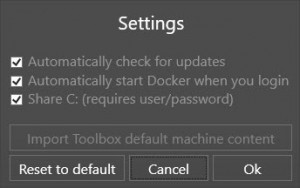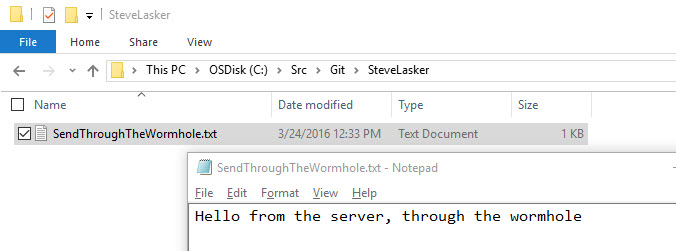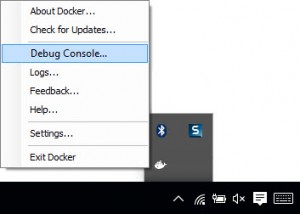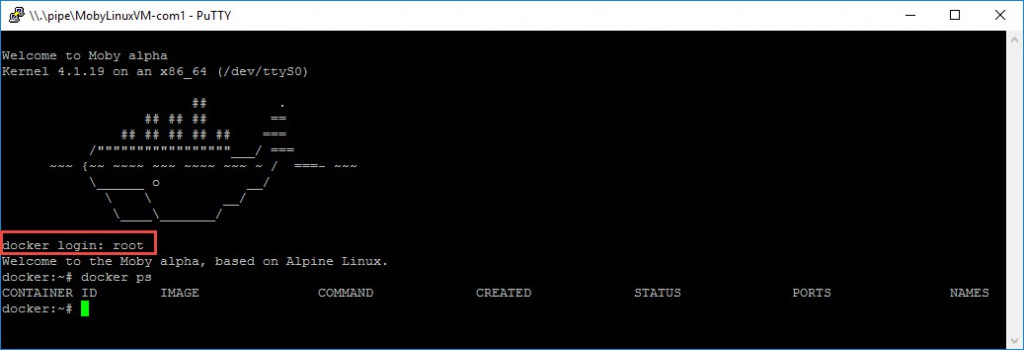Docker For Windows Beta Released
Today, docker announced and released a replacement for Docker Toolbox.
There are many enhancements, including my top ...6
- Works with Hyper-V
Docker Toolbox utilized VirtualBox. An alternate Virtualization technology that meant developers had to disable Hyper-V. Which means they can't run VMs or the various developer emulators, which also use Hyper-V - Starts automatically - no more docker-machine start default
The docker process will start automatically, by default.

- Resolves much of the problems VirutalBox had with Volume Mapping
VirtualBox used the c:\users directory, Which meant if you placed your project under c:\Source\Github, you couldn't access your code from within the container. There in theory was a way to fix that, but we never did get it working. Now, it's just a checkbox, provide your credentials for the host to mount the share, and voila. It's just that easy.


- Terminal Window directly to the host
There are times when you just want to jump on the host VM and see what's going on. Including troubleshooting your own container configurations, or the sometimes connectivity issues between your client and the host. Just right-click Moby in the system tray and choose the Developer Console
You'll need to login first, so just enter root and hit enter. You can then run your standard docker commands


- Update Notifications
In the spirit of ease of use, Docker has integrated auto update notifications, or the ability to disable it, and check for updates - No need for docker-machine, sort of...
This is slight bit of a change, and you may be switching between various hosts, including those in Azure or other hosts on your local network.
You may be used to using docker-machine env [hostname] | Invoke-Expression
Since Docker for Windows doesn't depend on docker-machine, you actually need to clear the environment variables. Which is the default case.
If you're switching between an AzureHost and your Docker for Windows Host, use: docker-machine env -u | Invoke-Expression to clear environment variables.
If you haven't used docker-machine, then you're good to go, and don't need to use docker-machine.
Docker Tools for Visual Studio Update
We have been working with docker on their latest tools and will release an update to support the local docker host shortly.
Give docker a shout, and give it a whirl. Developing apps in containers is far easier than just treating docker as a deployment technology...
Steve
Comments
- Anonymous
March 30, 2016
Most institutions I work with with not switch to Windows 10 very soon, but will continue to use Windows 7. Is this a long-term limitation or just a simpler solution for the beta?- Anonymous
April 11, 2016
The comment has been removed- Anonymous
April 14, 2016
The comment has been removed
- Anonymous
- Anonymous
- Anonymous
April 13, 2016
Hi Steve,Will Microsoft be implementing its own container technology alongside Docker? Perhaps a more robust, unprivileged OS container that can run multiple processes? Something similar to Canonical's LXD, which can also run Docker inside?In order to better support DevOps on Windows 10 will Microsoft be improving the UI and UX of Hyper-V Client? It's basically still as it was in 2008. With VMware Workstation likely to be discontinued after the firing of the team that developed it, now could be a good opportunity for Microsoft to significantly improve the desktop experience. To include great flexibility and features, supporting (as Workstation did):- nested virtualization- full OVA support (you know, now that Microsoft is embracing the open standards/source thing)- full 3D acceleration for all guests- full resolution support for non-Windows guests- multi-display support for all guests with that capability- vmware unity equivalent for seamless integration with Windows- much improved pass-through for usb devices, and others- an updated UI to rival WorkstationRight now, Hyper-V on Windows 10 is only good for Windows Desktop and Server guests and non-Windows servers. You can't run appliances, OVA files, complex environments that include nested KVM/QEMU aka GNS3, Mininet, etc), or have a good Linux desktop experience. Without a VMware Unity equivalent Hyper-V also reduces its appeal.I've never understood why Microsoft never developed Hyper-V to compete with VMware on the desktop. Now, with containers coming into the mix and DevOps (Devs, SysOps, Network) needing to run a range of apps and OS environments, a new Windows Hyper-V experience is just what is needed. Why doesn't Microsoft develop Hyper-V Client to become the go-to hypervisor of Windows 10?Cheers